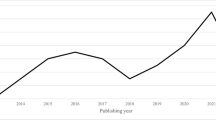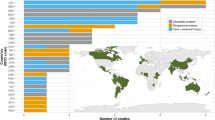Abstract
Cork oak “Montados” are a particular Mediterranean ecosystem, which can be found in Southern Portugal. Portuguese “Montados” are man-made ecosystems, mainly used for cork production and cattle farming, that support a high biological diversity. Current sustainable management techniques imply a shrub clearing with heavy machinery, which can be highly disruptive for soil biota. In order to evaluate the effects of understory vegetation management on soil epigeic macrofauna, five zones were defined along a chronosequence of shrub clearing: a non-disturbed zone (zone 5) and zones where understory vegetation was cut at 4–5 years (zone 4), at 3–4 years (zone 3), at 2 years (zone 2) and at 1 year (zone 1). A sixth zone (zone 6) was selected in a pasture, where cattle are occasionally present. Soil fauna was sampled using “pitfall” traps and sampling took place in autumn 2003. A total of 2,677 individuals, separated into 152 species and morphospecies, were caught in the traps. With the exception of zone 6, that presented a lower number of species, all the other zones from the chronosequence presented, in most cases, a similar number of taxa, species diversity (Shannon) and species richness (Margalef). Multivariate analysis separated recently disturbed zones (plus zone 6) from those intervened at longer time; groups like Formicidae, Scydmaenidae, most families from Araneae and insect larvae appeared closely associated to zones 3–5 (with a higher shrub cover and thick litter layers), whereas, other Hymenoptera, Gastropda and most Coleoptera families, appeared associated to recently disturbed zones (zones 1 and 2) and to zone 6, characterized by a lower shrub cover and a lower accumulation of litter. This separation indicates that effects of the intervention can endure for 2 or 3 years. After that time, the normal natural regeneration of the understory vegetation seems to support the restoration of the macrofauna community, thus indicating that the sustainable management strategy adopted, i.e., making a shrub cut every 5–6 years, seems not induce a significant effect on local species richness of soil epigeic macrofauna.


Similar content being viewed by others
References
Acácio V, Holmgren M, Rego F, Moreira F, Mohren G (2009) Are drought and wildfires turning Mediterranean cork oak forests into persistent shrublands? Agrofor Syst 76:389. doi:10.1007/s10457-008-9165-y
Almeida A, Tomé M (2009) Field sampling of cork value before extraction in Portuguese ‘Montados’. Agrofor Syst. doi:10.1007/s10457-009-9260-8
Bengtsson J (2002) Disturbance and resilience in soil animal communities. Eur J Soil Biol 38:119–125. doi:10.1016/S1164-5563(02)01133-0
Benito NP, Brossard M, Pasini A, Guimarães MF, Bobillier B (2004) Transformation of soil macroinvertebrate populations after native vegetation conversion to pasture cultivation (Brazilian Cerrado). Eur J Soil Biol 40:147–154. doi:10.1016/j.ejsobi.2005.02.002
Blondel J (2006) The ‘design’ of Mediterranean landscapes: a millennial story of humans and ecological systems during the historic period. Hum Ecol 34:713. doi:10.1007/s10745-006-9030-4
Cammell ME, Way MJ, Paiva MR (1996) Diversity and structure of ant communities associated with oak, pine, eucalyptus and arable habitats in Portugal. Insectes Soc 43:37. doi:10.1007/BF01253954
Clarke K, Gorley R (2001) PRIMER v5: user manual/tutorial. PRIMER-E, Plymouth
Costa A, Oliveira A, Vidas F, Borges J (2009) An approach to cork oak forest management planning: a case study in southwestern Portugal. Eur J For Res doi:10.1007/s10342-009-0326-y
da Silva P, Aguiar C, Niemelä J, Sousa J, Serrano A (2008) Diversity patterns of ground-beetles (Coleoptera: Carabidae) along a gradient of land-use disturbance. Agric Ecosyst Environ 124:270–274. doi:10.1016/j.agee.2007.10.007
de Bruyn LAL (1997) The status of soil macrofauna as indicators of soil health to monitor the sustainability of Australian agricultural soils. Ecol Econ 23:167. doi:10.1016/S0921-8009(97)00052-9
Deharveng L, Dalens H, Drugmand D, Simon-Benito JC, da Gama MM, Sousa JP, Gers C, Bedos A (2000) Endemism mapping and biodiversity conservation in Western Europe: an Arthropod Perspective. Belg J Entomol 3:59–75
Delbaere B, Pinborg U, Heath M (2002) Biodiversity indicators and monitoring: moving towards implementation. Proceedings of a side event held at CBD/COP6. ECNC. http://www.ecnc.org/publications/technicalreports/biodiversity-indicators-and-monitoring. Accessed 19 Aug 2009
Eichhorn M, Paris P, Herzog F, Incoll L, Liagre F, Mantzanas K, Mayus M, Moreno G, Papanastasis V, Pilbeam D, Pisanelli A, Dupraz C (2006) Silvoarable systems in Europe—past, present and future prospects. Agrofor Syst 67:29. doi:10.1007/s10457-005-1111-7
EPBRS (2002a) Agreement of the participants of the European platform for biodiversity research strategy held under the Danish presidency of the EU in Silkeborg, Denmark, 4–6 October 2002 concerning “Auditing the Ark—science based monitoring of biodiversity”. EPBRS. http://bioplatform.info/decl_silkeborg.htm. Accessed 14 Sept 2009
EPBRS (2002b) Recommendations of the participants of the European platform for biodiversity research strategy held under the Spanish presidency of the EU in Almeria, Spain, 11–13 May 2002 concerning “European heritage under threat: biodiversity in Mediterranean ecosystems”. EPBRS. http://bioplatform.info/decl_almeria.htm. Accessed 14 Sept 2009
Fabbio G, Merlo M, Tosi V (2003) Silvicultural management in maintaining biodiversity and resistance of forests in Europe—the Mediterranean region. J Environ Manage 67:67–76. doi:10.1016/S0301-4797(02)00189-5
Frouz J (1999) Use of soil dwelling Diptera (Insecta, Diptera) as bioindicators: a review of ecological requirements and response to disturbance. Agric Ecosyst Environ 74:167. doi:10.1016/S0167-8809(99)00036-5
Funk JL, Cleland EE, Suding KN, Zavaleta ES (2008) Restoration through reassembly: plant traits and invasion resistance. Trends Ecol Evol 23:695. doi:10.1016/j.tree.2008.07.013
Gomez-Limon J, Fernandez JVL (1999) Changes in use and landscape preferences on the agricultural-livestock landscapes of the central Iberian Peninsula (Madrid, Spain). Landsc Urban Plann 44:165–175. doi:10.1016/S0169-2046(99)00020-1
Grill A, Knoflach B, Cleary DFR, Kati V (2005) Butterfly, spider, and plant communities in different land-use types in Sardinia, Italy. Biodivers Conserv 14:1281. doi:10.1007/s10531-004-1661-4
Hemerick L, Brussard L (2002) Diversity of soil macro-invertebrates in grasslands under restoration succession. Eur J Soil Biol 38:145–150. doi:10.1016/S1164-5563(02)01136-6
Keddy PA (1992) Assembly and response rules: two goals for predictive community ecology. J Veg Sci 3:157–164. doi:10.2307/3235676
Knoepp JD, Coleman DC, Crossley DA, Clark JS (2000) Biological indices of soil quality: an ecosystem case study of their use. For Ecol Manage 138:357. doi:10.1016/S0378-1127(00)00424-2
Larsen KJ, Work TT, Purrington FF (2003) Habitat use patterns by ground beetles (Coleoptera: Carabidae) of northeastern Iowa. Pedobiologia 47:288–299. doi:10.1078/0031-4056-00192
Lavelle P, Decaëns T, Aubert M, Barot S, Blouin M, Bureau F, Margerie F, Mora P, Rossi J-P (2006) Soil invertebrates and ecosystem services. Eur J Soil Biol 42:S3–S15. doi:10.1016/j.ejsobi.2006.10.002
LNEC (1970) Solos—Análise granulométrica por peneiração húmida. LNEC—E 239. Laboratório Nacional de Engenharia Civil, Lisbon, Portugal
Magurran AE (1991) Ecological diversity and its measurement. Chapman & Hall, London
Neher D (1999) Soil community composition and ecosystem processes: Comparing agricultural ecosystems with natural ecosystems. Agrofor Syst 45:159. doi:10.1023/A:1006299100678
New TR (2005) Invertebrate conservation and agricultural ecosystems. Cambridge University Press, Cambridge
Perner J, Malt S (2003) Assessment of changing agricultural land use: response of vegetation, ground-dwelling spiders and beetles to the conversion of arable land into grassland. Agric Ecosyst Environ 98:169. doi:10.1016/S0167-8809(03)00079-3
Pinto-Correia T (1993) Threatened landscape in Alentejo, Portugal: the ‘Montado’ and other ‘agro-silvo-pastoral’ systems. Landsc Urban Plann 24:43. doi:10.1016/0169-2046(93)90081-N
Pinto-Correia T, Mascarenhas J (1999) Contribution to the extensification/intensification debate: new trends in the Portuguese Montado. Landsc Urban Plann 46:125–131. doi:10.1016/S0169-2046(99)00036-5
Rainio J, Niemelä J (2003) Ground beetles (Coleoptera: Carabidae) as bioindicators. Biodivers Conserv 12:487. doi:10.1023/A:1022412617568
Rego F, Dias S (2000) Monitorização da biodiversidade nas florestas portuguesas. Projecto PAMAF—Medida 4—Estudos estratégicos. Estação Florestal Nacional
Retana J, Cerdá X (2000) Patterns of diversity and composition of Mediterranean ground ant communities tracking spatial and temporal variability in the thermal environment. Oecologia 123:436. doi:10.1007/s004420051031
Ruiz Camacho N, Velasquez E, Pando A, Decaëns T, Dubs F, Lavelle P (2009) Indicateurs synthéthiques de la qualité du sol. Étude et Gestion des Sols 16:323–338
Sauberer N, Zulka KP, Abensperg-Traun M, Berg H-M, Bieringer G, Milasowszky N, Moser D, Plutzar C, Pollheimer M, Storch C, Tröstl R, Zechmeister H, Grabherr G (2004) Surrogate taxa for biodiversity in agricultural landscapes of eastern Austria. Biol Conserv 117:181. doi:10.1016/S0006-3207(03)00291-X
Scarascia-Mugnozza G, Oswald H, Piussi P, Radoglou K (2000) Forests of the Mediterranean region: gaps in knowledge and research needs. For Ecol Manage 132:97. doi:10.1016/S0378-1127(00)00383-2
Sousa JP, Vingada JV, Barrocas H, Gama MM (1997) Effects of introduced exotic tree species on Collembola communities: the importance of management techniques. Pedobiologia, 145–153. doi:10.1016/j.pedobi.2004.06.004
Ter Braak CJF, Smilauer P (1998) CANOCO reference manual and user’s guide to CAnoco for Windows: software for canonical community ordination (version 4). Microcomputer Power, Ithaca
Vanbergen AJ, Woodcock BA, Watt AD, Niemelä J (2005) Effect of land-use heterogeneity on carabid communities at the landscape scale. Ecography 28:3–16. doi:10.1111/j.0906-7590.2005.03991.x
Velasquez E, Lavelle P, Andrade M (2007) GIQS: a multifunctional indicator of soil quality. Soil Biol Biochem 39:3066–3080. doi:10.1016/j.soilbio.2007.06.013
Zar JH (1996) Biostatistical analysis. Prentice-Hall International, London
Acknowledgments
We would like to acknowledge: Herdade do Freixo do Meio for providing the study-site as well as guidance on field and all information needed to select sampling zones; everyone at Soil Laboratory in Coimbra’s Life Sciences Department, for their help and support. The study was sponsored by the research project “Montados II” funded by the Fundação para a Ciência e Tecnologia (POCTI/AGG/42349/2001).
Author information
Authors and Affiliations
Corresponding author
Rights and permissions
About this article
Cite this article
Mendes, S.M., Santos, J., Freitas, H. et al. Assessing the impact of understory vegetation cut on soil epigeic macrofauna from a cork-oak Montado in South Portugal. Agroforest Syst 82, 139–148 (2011). https://doi.org/10.1007/s10457-010-9358-z
Received:
Accepted:
Published:
Issue Date:
DOI: https://doi.org/10.1007/s10457-010-9358-z




